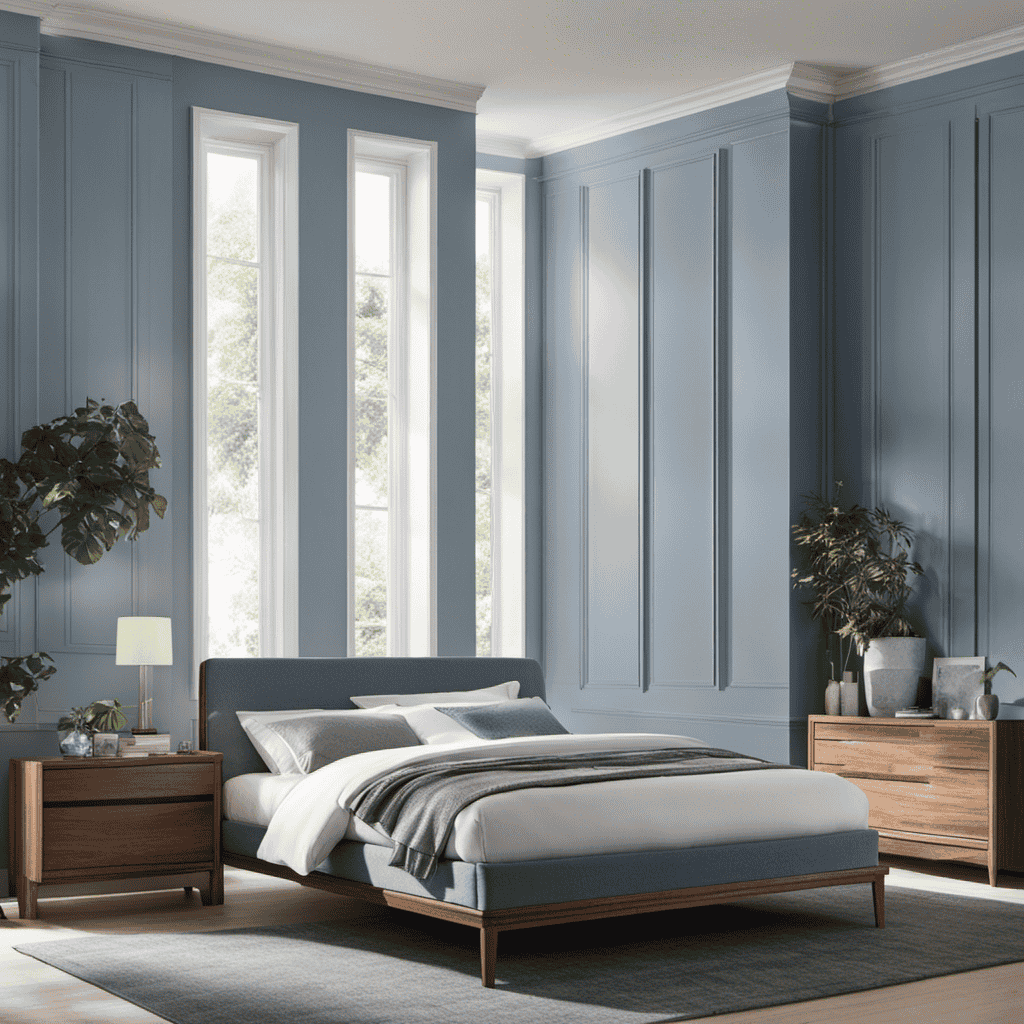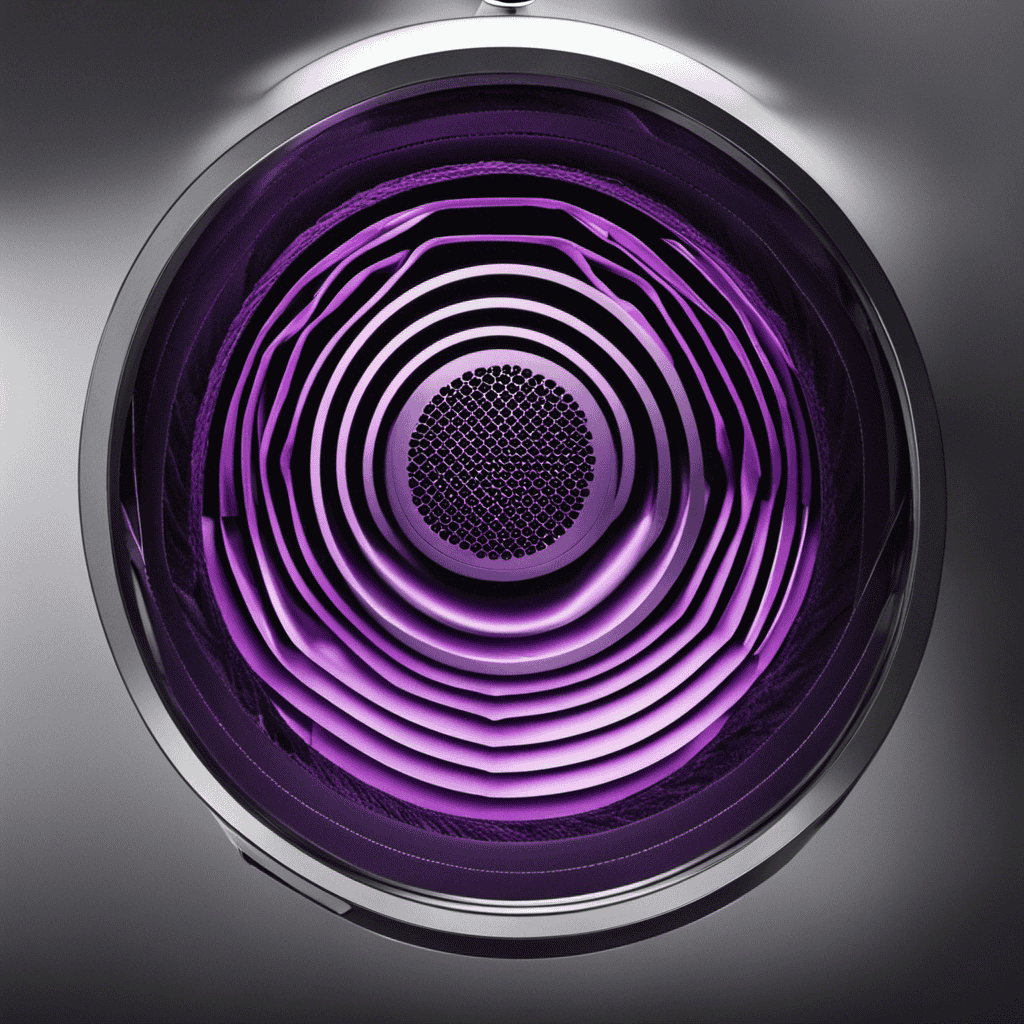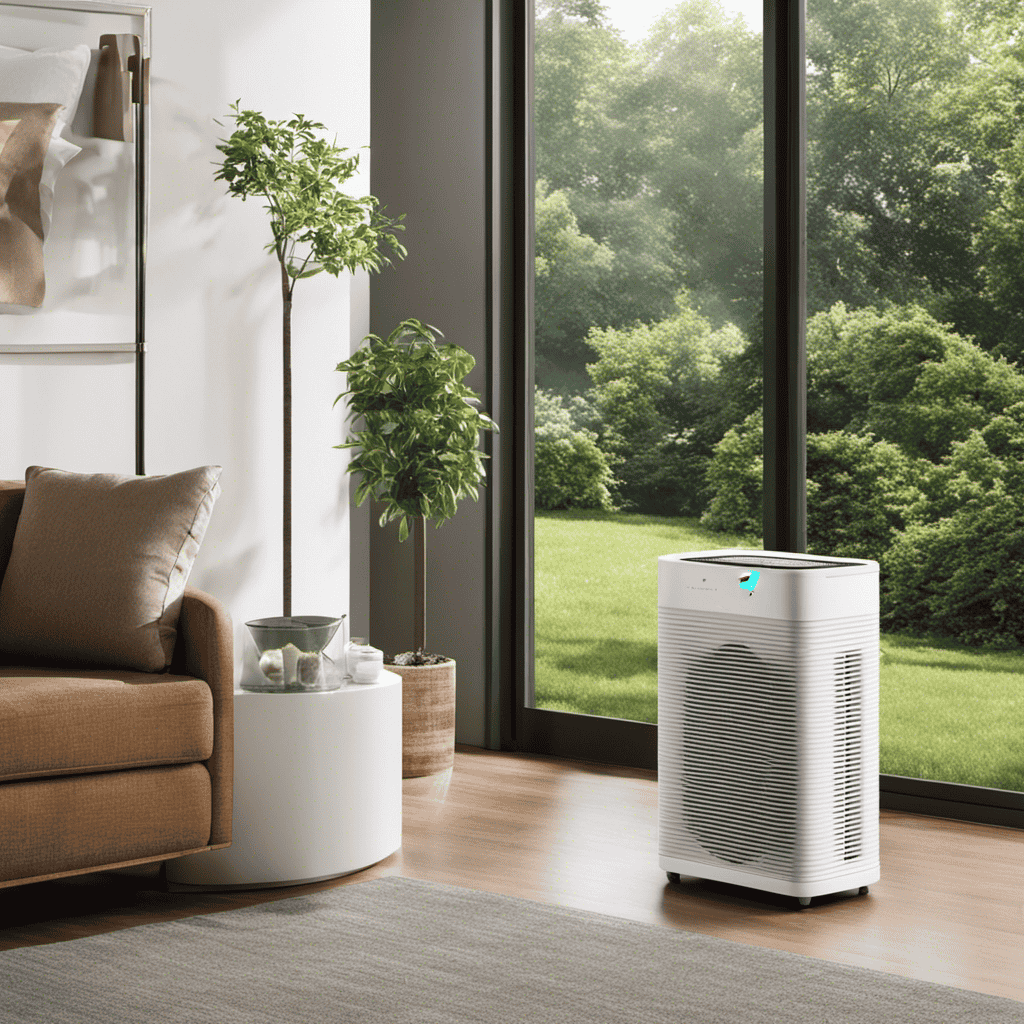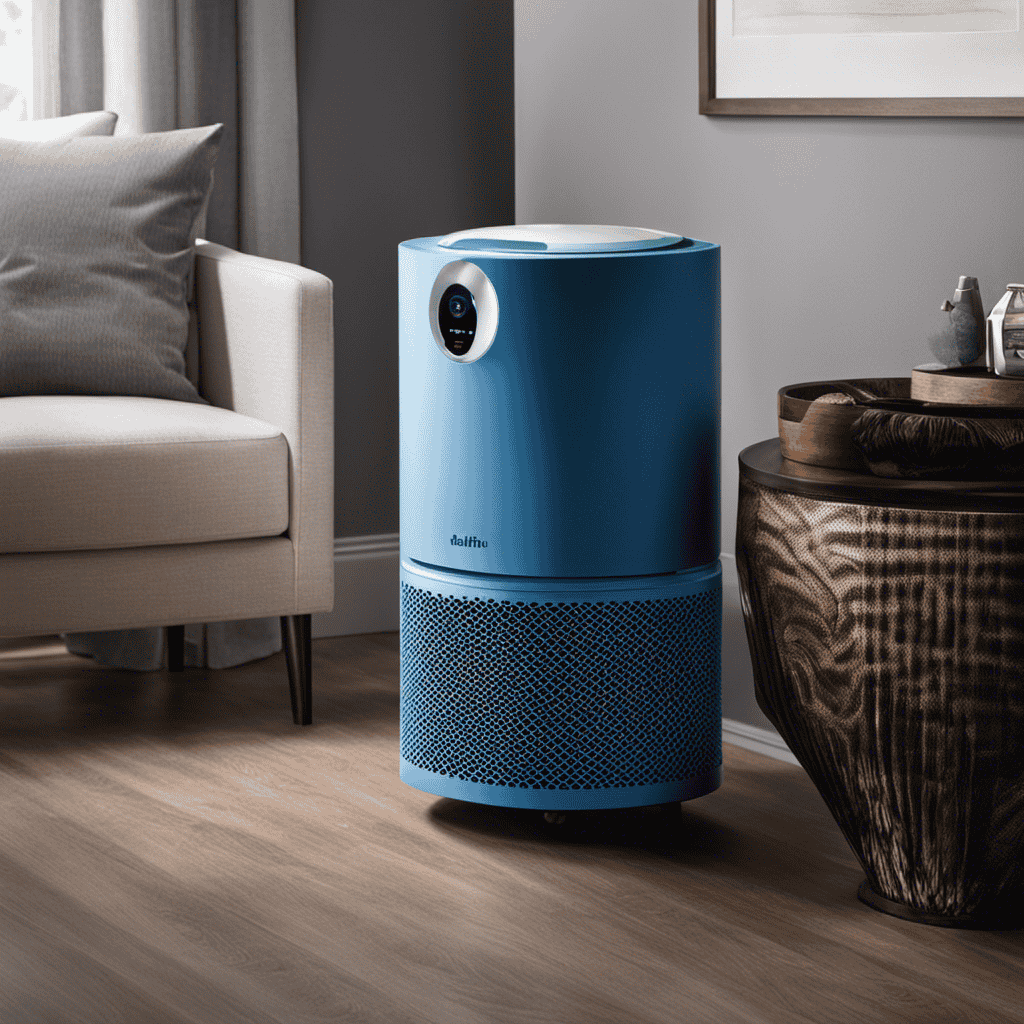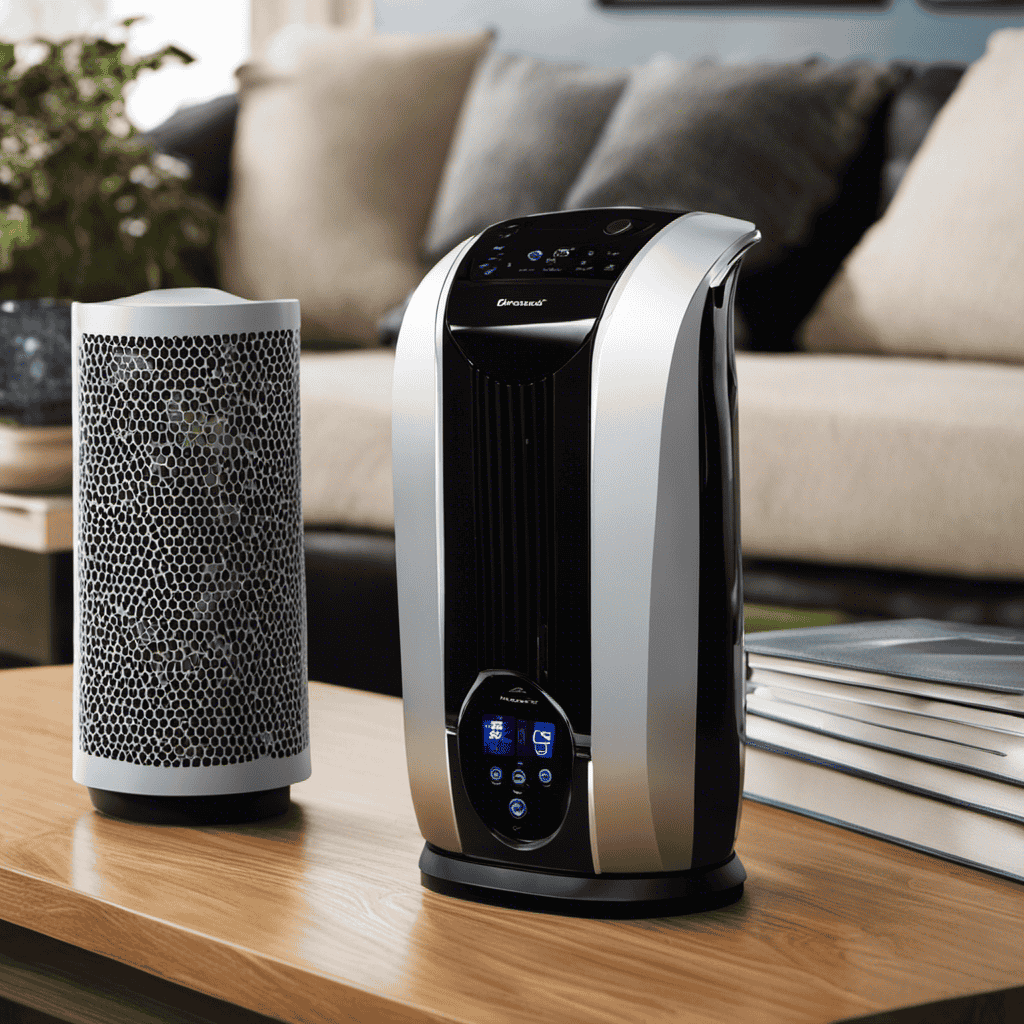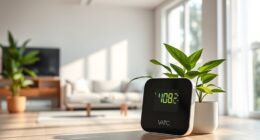Being someone who deals with allergies, I’m familiar with the challenges that come from indoor air pollutants. This led me to conduct research on air purifiers.
Let me tell you, these devices are life-changing! They work by removing harmful particles from the air, such as dust, pollen, and pet dander. Not only do they improve indoor air quality, but they also help alleviate allergy symptoms.
In this article, we’ll delve into the nitty-gritty details of what an air purifier does and how it can benefit you.
Key Takeaways
- Air purifiers improve indoor air quality by removing pollutants and allergens.
- They use different types of filters such as HEPA filters, activated carbon filters, and electrostatic filters to capture and eliminate contaminants.
- Air purifiers can remove allergens like dust mites, pet dander, pollen, as well as harmful pollutants like VOCs, mold, and tobacco smoke.
- Breathing clean air from air purifiers can prevent respiratory problems, improve sleep quality, and enhance overall health.
The Basics of Air Purifiers
So, let’s talk about what an air purifier actually does.
Air purifiers are devices designed to improve the quality of indoor air by removing pollutants and allergens. They work by drawing in air from the surrounding environment and passing it through various types of air filters. These filters are specifically designed to capture different types of contaminants, such as dust, pollen, pet dander, and even harmful gases.
There are several types of air filters commonly used in air purifiers, including HEPA filters, activated carbon filters, and electrostatic filters. Each filter has its own unique way of trapping and removing particles, ensuring that the air you breathe is clean and healthy.
The benefits of clean air cannot be overstated. It can help reduce allergies, improve respiratory health, and create a more comfortable living environment. Investing in an air purifier can greatly contribute to improving your overall well-being.
Types of Air Pollutants Removed by Air Purifiers
When it comes to indoor air quality, there are a number of common pollutants that can negatively impact our health. These can include allergens like dust mites, pet dander, and pollen, as well as volatile organic compounds (VOCs) emitted from cleaning products, furniture, and building materials.
Common Indoor Pollutants
Common indoor pollutants can be effectively removed by an air purifier. Indoor air pollution is a major concern, as poor indoor air quality can have detrimental effects on our health. The table below provides a visual representation of some common indoor pollutants and their sources:
| Indoor Pollutant | Sources |
|---|---|
| Volatile Organic Compounds (VOCs) | Cleaning products, paints, furniture, carpets |
| Dust and Allergens | Pet dander, pollen, dust mites |
| Mold and Mildew | Damp areas, bathrooms, basements |
| Tobacco Smoke | Smoking indoors |
| Formaldehyde | Insulation, furniture, pressed wood products |
These pollutants can cause a range of health issues, including respiratory problems, allergies, and even long-term effects like cancer. An air purifier helps by filtering out these pollutants and improving indoor air quality. It uses various technologies like HEPA filters, activated carbon filters, and UV light to capture and destroy these harmful particles. By investing in an air purifier, you can ensure a healthier and cleaner indoor environment for you and your family.
Health Benefits of Purification
Investing in an air purifier can greatly improve your health by reducing indoor pollutants and providing cleaner air. Clean air is vital for our overall well-being, as it has numerous benefits for our health.
Breathing in clean air can help prevent respiratory problems such as asthma, allergies, and other respiratory conditions. Additionally, clean air can improve sleep quality, enhance cognitive function, and boost immune system function.
On the other hand, long-term exposure to air pollution can have severe consequences on our health. Studies have shown that prolonged exposure to indoor pollutants can lead to chronic respiratory diseases, cardiovascular problems, and even cancer.
How Air Purifiers Improve Indoor Air Quality
As I delve into the topic of how air purifiers improve indoor air quality, it is important to understand the benefits they provide and the common indoor pollutants they target.
Air purifiers offer numerous advantages, such as removing allergens, reducing odors, and eliminating harmful particles.
These devices can effectively tackle common indoor pollutants like dust, pollen, pet dander, mold spores, and volatile organic compounds (VOCs), creating a healthier living environment for individuals.
Benefits of Air Purifiers
One of the benefits of using an air purifier is that it helps to remove harmful pollutants from the air, improving the overall air quality in your home. Air purifiers use advanced technology to capture and eliminate various pollutants such as dust, pet dander, pollen, mold spores, and even volatile organic compounds (VOCs).
These devices are equipped with filters that trap these particles, preventing them from circulating in your living space. Additionally, air purifiers can also help to reduce unpleasant odors by removing smoke, cooking smells, and pet odors from the air.
Another advantage of using an air purifier is that it can be a cost-effective solution in the long run. Although the initial cost of purchasing an air purifier may seem high, the improved air quality can lead to better health outcomes, potentially reducing medical expenses related to respiratory issues.
Common Indoor Pollutants
Using an air purifier can significantly improve the overall air quality in your home by removing common indoor pollutants such as dust, pet dander, pollen, and mold spores. These pollutants can have various effects on our health, ranging from mild irritation to severe respiratory issues. Understanding the types of indoor pollutants and their effects is crucial in creating a healthy living environment.
| Types of Indoor Pollutants | Effects of Indoor Pollution |
|---|---|
| Dust | Irritation, allergies |
| Pet dander | Allergies, asthma attacks |
| Pollen | Allergies, respiratory issues |
| Mold spores | Allergies, respiratory issues |
Dust, a common indoor pollutant, can cause irritation in the eyes, nose, and throat. Pet dander, often found in homes with furry animals, can trigger allergic reactions and asthma attacks. Pollen, especially during certain seasons, can lead to allergies and respiratory problems. Mold spores, commonly found in damp areas, can also cause allergies and respiratory issues. By using an air purifier, you can effectively remove these pollutants and create a healthier indoor environment.
Key Components of an Air Purifier
Do you know what the key components of an air purifier are? Understanding filtration technology is essential when it comes to selecting and maintaining an air purifier. Here are three vital components to consider:
-
Pre-filter: This initial layer captures large particles like dust, pet hair, and lint, preventing them from clogging the main filter.
-
HEPA Filter: High-Efficiency Particulate Air (HEPA) filters remove 99.97% of airborne particles as small as 0.3 microns. They trap allergens, pollen, mold spores, and even bacteria.
-
Activated Carbon Filter: Designed to eliminate odors and chemical pollutants, activated carbon filters contain a porous surface that absorbs gases, volatile organic compounds (VOCs), and harmful fumes.
Understanding air filtration systems is crucial to maintaining a healthy indoor environment. Now that we’ve explored the key components, let’s delve into the various types of air purifiers and their specific technologies.
Understanding Air Filtration Systems
When it comes to air filtration systems, understanding the types of filters is crucial.
Different filters, such as HEPA filters or activated carbon filters, target specific pollutants in the air, providing a comprehensive purification process.
This process involves trapping particles, eliminating odors, and reducing harmful contaminants, resulting in cleaner and healthier air for breathing.
Types of Filters
To effectively filter out pollutants from the air, you need to understand the different types of filters available for your air purifier. Here are three types of filters commonly used in air purifiers and their effectiveness in removing pollutants:
-
HEPA Filters: These high-efficiency particulate air filters are considered the gold standard for air purification. They can capture particles as small as 0.3 microns with an efficiency of 99.97%. HEPA filters are highly effective in removing dust, pollen, pet dander, and other airborne allergens.
-
Activated Carbon Filters: These filters contain activated carbon, which has a large surface area that can absorb and trap gases, odors, and volatile organic compounds (VOCs). Activated carbon filters are particularly useful for eliminating unpleasant smells and chemical fumes.
-
Electrostatic Filters: These filters use an electrostatic charge to attract and capture airborne particles. They are effective in removing larger particles like dust and pet hair. However, they may require regular cleaning to maintain their efficiency.
Regular air purifier maintenance, including filter replacement or cleaning, is essential to ensure the continued effectiveness of the filters in removing pollutants from the air.
Purification Process Explained
The purification process starts by pulling in the surrounding air through the filters. These filters are designed to capture and remove various airborne particles and pollutants, such as dust, pollen, pet dander, and smoke.
The efficiency of the purification process is crucial in ensuring that the air we breathe is clean and healthy. High-efficiency filters are capable of trapping even the smallest particles, providing a higher level of purification. However, it is essential to strike a balance between purification process efficiency and its impact on energy consumption.
While more efficient filters may offer superior air purification, they may also require more energy to operate. Finding the right balance is important to ensure optimal performance while minimizing energy consumption.
Transitioning into the subsequent section about the benefits of clean air, the purification process plays a vital role in improving indoor air quality and promoting a healthier living environment.
Benefits of Clean Air
You can experience numerous benefits from breathing clean air, such as improved respiratory health and a reduced risk of allergies. Here are three specific benefits of breathing clean air:
-
Reduced risk of respiratory illnesses: Breathing clean air helps to reduce the exposure to harmful particles and chemicals that can irritate the respiratory system. This lowers the risk of developing respiratory conditions such as asthma, bronchitis, and chronic obstructive pulmonary disease (COPD).
-
Improved lung function: Clean air allows your lungs to function optimally. When the air you breathe is free from pollutants, your lungs can efficiently exchange gases, delivering oxygen to your bloodstream and removing carbon dioxide. This leads to improved overall lung function and better respiratory health.
-
Enhanced overall well-being: Breathing clean air can have a positive impact on your overall well-being. It can improve sleep quality, increase energy levels, and boost immune function. Clean air also reduces the risk of developing allergies, which can significantly affect your quality of life.
Benefits of Using an Air Purifier
Using an air purifier can greatly improve the air quality in your home. Not only does it remove harmful pollutants and allergens, but it also has several other benefits. In offices, air purification is essential for maintaining a healthy work environment. The table below highlights some of the key benefits of air purification in offices:
| Benefits | Description |
|---|---|
| Reduces Sick Leave | Air purifiers help eliminate germs and bacteria, leading to a decrease in sick days taken by employees. |
| Increases Productivity | Clean air promotes better focus and concentration, resulting in increased productivity among workers. |
| Improves Air Circulation | Proper air circulation reduces stuffiness and creates a more comfortable working environment. |
| Enhances Overall Well-being | Breathing clean air improves employees’ overall health and well-being, leading to higher job satisfaction. |
Air purifiers are also beneficial for those suffering from asthma. They help reduce asthma symptoms by eliminating triggers such as dust mites, pet dander, and pollen from the air. This can lead to a significant improvement in breathing and a decrease in asthma attacks. Whether it’s in an office or at home, investing in an air purifier can provide numerous benefits for your health and well-being.
Factors to Consider When Choosing an Air Purifier
When selecting an air purifier, there are several key criteria that should be considered. These criteria include the size of the room, the type of pollutants present, and the desired level of filtration.
Additionally, there are important features to consider such as the CADR rating, filter replacement frequency, and noise level.
Considering these factors will ensure that the chosen air purifier effectively meets the specific needs and requirements of the environment.
Key Purifier Selection Criteria
One important factor to consider when selecting an air purifier is its filtration system. The quality of the air purifier’s filtration system determines how effectively it can remove pollutants from the air.
Here are three key criteria to consider when choosing an air purifier:
-
Air Purifier Brands: Look for reputable brands that have a proven track record in producing high-quality air purifiers. Brands like Honeywell, Blueair, and Coway are well-known for their reliable and effective air purification systems.
-
Cost of Air Purifiers: Determine your budget and consider the long-term costs of owning an air purifier. While some models may have a higher upfront cost, they may also have lower maintenance and filter replacement costs over time. It’s important to find a balance between affordability and performance.
-
Filtration Technology: Consider the specific type of filtration technology used in the air purifier. HEPA filters are highly effective at removing airborne particles, while activated carbon filters can help eliminate odors and VOCs. Some advanced models may even incorporate additional technologies like UV-C light or ionizers for further purification.
Important Features to Consider
Now that we have discussed the key purifier selection criteria, let’s dive into the important features to consider when choosing an air purifier. These factors play a crucial role in determining the effectiveness and suitability of the purifier for your specific needs.
One of the most important factors to consider is the purification technology used. Different air purifiers employ various technologies such as HEPA filters, activated carbon filters, or electrostatic precipitators. Understanding the benefits and limitations of each technology will help you make an informed decision.
Another key consideration is the coverage area of the air purifier. It is essential to choose a purifier that can effectively clean the air in the size of the room where it will be placed.
Additionally, noise levels, energy consumption, and maintenance requirements should also be taken into account. A quiet purifier with low energy consumption and easy-to-maintain filters can provide a hassle-free experience.
Considering these important factors and key considerations will ensure that you select an air purifier that best meets your needs and provides you with clean and fresh air in your living space.
Common Misconceptions About Air Purifiers
Don’t believe the misconception that air purifiers only remove dust from the air. While it’s true that air purifiers are effective at capturing and removing dust particles, their benefits extend far beyond that. Here are three common misconceptions about air purifiers and the actual benefits they provide:
-
Misconception: Air purifiers are only useful for people with allergies.
Reality: Air purifiers can benefit everyone, not just those with allergies. They help improve indoor air quality by removing pollutants such as pet dander, smoke, and volatile organic compounds (VOCs), which can have detrimental effects on our health. -
Misconception: Air purifiers are noisy and disrupt sleep.
Reality: Many modern air purifiers are designed to operate quietly, allowing you to enjoy a peaceful night’s sleep without any disturbance. -
Misconception: Air purifiers are expensive to operate.
Reality: While the initial cost of purchasing an air purifier may seem high, the long-term benefits outweigh the expenses. They can help reduce medical costs associated with respiratory issues and provide a healthier living environment for you and your family.
The Role of HEPA Filters in Air Purifiers
HEPA filters, found in many air purifiers, effectively capture and remove tiny particles like pollen, pet dander, and smoke from the air. These filters are known for their high efficiency in trapping particles as small as 0.3 microns, making them highly effective in improving indoor air quality.
The key to their efficacy lies in their dense fiber structure, which creates a barrier for the particles to pass through. However, it is important to regularly replace HEPA filters to ensure their continued efficiency. Over time, as the filters become clogged with trapped particles, their ability to capture new ones diminishes.
Regular filter replacement not only helps maintain the effectiveness of the air purifier but also ensures that the air you breathe is consistently clean and free from harmful pollutants.
Can Air Purifiers Help With Allergies
If you suffer from allergies, using an air purifier can greatly reduce the amount of pollen and pet dander in your indoor environment. Here are three ways air purifiers can help with allergies:
-
Air purifiers remove allergens: Air purifiers are designed to capture and filter out airborne allergens such as pollen, dust mites, and pet dander. They have a HEPA (High-Efficiency Particulate Air) filter that can trap particles as small as 0.3 microns, ensuring that the air you breathe is clean and free from allergens.
-
Air purifiers reduce asthma triggers: Asthma is a respiratory condition often triggered by allergens. Air purifiers can help alleviate asthma symptoms by eliminating common triggers like dust, mold spores, and pet allergens. By reducing the presence of these triggers in the air, air purifiers can create a healthier indoor environment for individuals with asthma.
-
Air purifiers improve air quality: Poor indoor air quality can worsen respiratory conditions and allergies. Air purifiers work by circulating and filtering the air, removing pollutants and improving air quality. This can help reduce symptoms such as coughing, sneezing, and wheezing, providing relief for those with respiratory conditions.
Air Purifiers Vs. Air Cleaners: What’s the Difference
Air purifiers and air cleaners may seem similar, but there are key differences between the two.
When it comes to improving indoor air quality, the choice between air purifiers and humidifiers depends on your specific needs.
Air purifiers are designed to remove pollutants from the air, such as dust, pollen, and pet dander. They use filters or technologies like ionization or UV-C light to capture or destroy these particles.
On the other hand, humidifiers add moisture to the air, which can help alleviate dryness and respiratory issues.
When comparing air purifiers to plants, studies have shown that air purifiers are more effective in removing air pollutants. While plants can improve air quality to some extent, they are not as powerful as air purifiers in eliminating harmful particles.
Ultimately, the best choice for improving indoor air quality depends on your specific needs and circumstances.
How to Properly Maintain an Air Purifier
To properly maintain an air purifier, you should regularly clean or replace the filters and ensure that the device is free from dust and debris. Here are three important steps to follow for the proper cleaning and filter replacement of an air purifier:
-
Clean or replace filters: Depending on the type of air purifier you have, the filters may need to be cleaned or replaced every 3 to 6 months. Check the manufacturer’s instructions for guidance. Cleaning the filters typically involves removing them from the device and gently washing them with water or a mild detergent. If the filters are disposable, simply remove and replace them with new ones.
-
Clean the exterior: Dust and debris can accumulate on the exterior of the air purifier, affecting its performance. Regularly wipe down the device with a soft cloth or use a vacuum cleaner with a brush attachment to remove any dirt or dust.
-
Check for dust and debris inside: Occasionally, dust and debris can accumulate inside the air purifier, reducing its efficiency. Open the device and inspect the interior for any build-up. Use a soft brush or compressed air to remove any dust or debris that may have settled inside.
Proper cleaning and filter replacement are essential to ensure that your air purifier continues to effectively improve indoor air quality. Regular maintenance will help prolong the life of the device and ensure optimal performance.
Air Purifiers for Different Room Sizes
Different-sized rooms require air purifiers of varying capacities to effectively improve indoor air quality. When it comes to large spaces, such as open-concept living areas or offices, it is essential to choose air purifiers specifically designed to handle the volume of air in these rooms. These air purifiers have higher CADR (Clean Air Delivery Rate) ratings, which indicate their ability to filter larger volumes of air.
On the other hand, if you are looking for an air purifier for your car, there are compact and portable options available that can effectively clean the air inside your vehicle. These car air purifiers are designed to remove pollutants and odors from the confined space of your car cabin.
Now, let’s move on to addressing odors with air purifiers. As we explore how air purifiers can address odors, it is important to understand that different air purifiers employ various methods to combat unwanted smells.
Addressing Odors With Air Purifiers
When tackling odors, air purifiers use different methods to combat unwanted smells. Here are three ways air purifiers can address odors and improve indoor air quality:
-
Activated Carbon Filters: These filters are designed to trap and neutralize odorous molecules. The activated carbon has a large surface area that can adsorb and eliminate pet odors, cooking smells, and other unpleasant odors.
-
Ionizers: Air purifiers equipped with ionizers release negatively charged ions into the air. These ions attach to odorous particles, causing them to become heavy and fall to the ground or get trapped in the air purifier’s filters. This helps to remove cooking smells and other strong odors.
-
Ozone Generators: Some air purifiers produce ozone, a reactive gas that can break down and eliminate odors. However, it’s important to note that ozone generators should be used with caution as high levels of ozone can be harmful to human health.
Air Purifiers for Specific Needs: Pets, Smoke, and More
If you have pets or deal with smoke, there are air purifiers specifically designed to address these needs. These purifiers utilize advanced filtration systems to remove allergens and irritants from the air, providing a cleaner and healthier environment.
Air purifiers for allergies and asthma are essential for those who suffer from respiratory conditions. HEPA filters are commonly used in air purifiers for allergies, as they effectively capture particles as small as 0.3 microns, including pet dander, pollen, and dust mites.
Activated carbon filters are beneficial in air purifiers for smoke, as they can absorb odors and chemicals. It is important to choose an air purifier that is appropriate for your specific needs, ensuring that it effectively targets the allergens and irritants that trigger your allergies or asthma symptoms.
Frequently Asked Questions
Are There Any Health Risks Associated With Using an Air Purifier?
There are potential side effects associated with using an air purifier, but the health benefits are worth considering. It is important to research and choose a purifier that suits your needs and minimizes any risks.
How Long Does It Take for an Air Purifier to Clean the Air in a Room?
It takes some time for an air purifier to clean the air in a room. Factors like the size of the room, the air purifier’s effectiveness, and regular maintenance all play a role in how long it takes.
Can Air Purifiers Remove Viruses and Bacteria From the Air?
Air purifiers effectively remove viruses and bacteria from the air, providing numerous benefits for people with respiratory conditions. Their ability to trap and eliminate allergens makes them a valuable tool for improving indoor air quality.
Do Air Purifiers Produce Any Noise While Operating?
Air purifiers can produce noise while operating, but the noise level varies depending on the model. Excessive noise can negatively impact sleep quality. Consider choosing a model with a low noise level for a more peaceful environment.
Can Air Purifiers Eliminate Pet Dander and Odors Effectively?
Air purifiers are great for eliminating pet dander and odors. They’re super effective at reducing allergens and keeping your home smelling fresh. I’ve compared different models and found they work wonders.
Conclusion
After diving deep into the world of air purifiers, it’s safe to say that these little machines are nothing short of magical! They have the power to banish all those pesky air pollutants, leaving your indoor air cleaner than ever before.
With their innovative filtration systems and clever design, air purifiers are the superheroes of indoor air quality. So, if you want to breathe in air that’s as fresh as a mountain breeze, look no further than an air purifier. It’s the ultimate weapon against all things smelly and stuffy!
